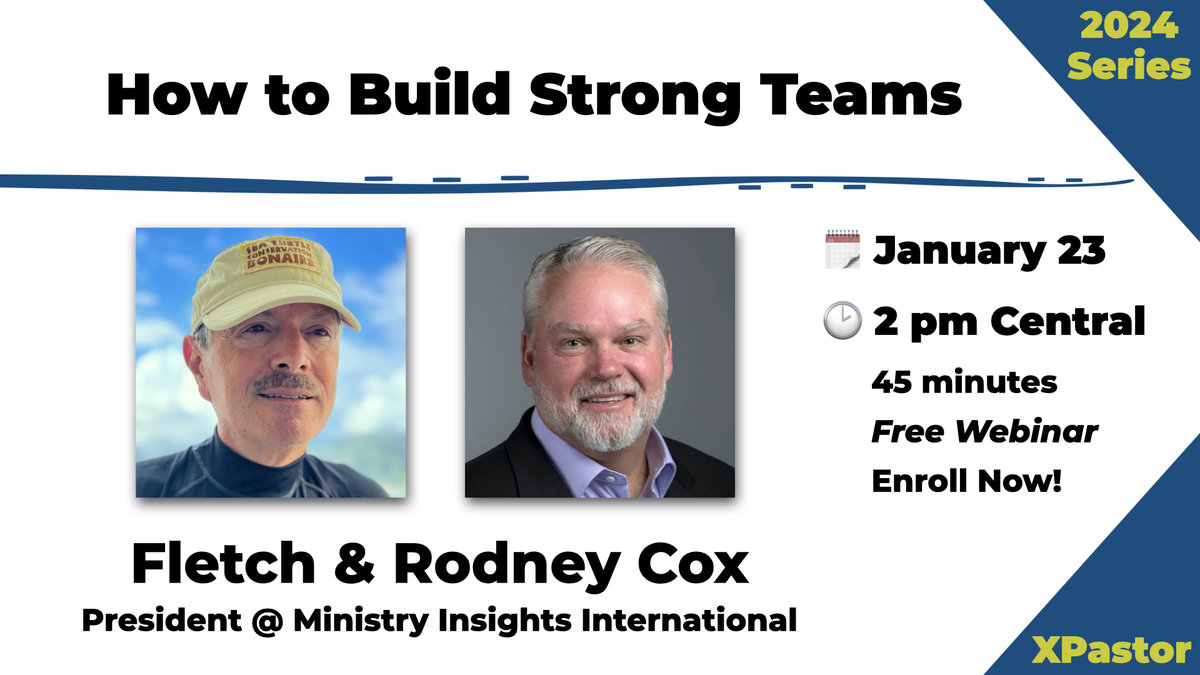By definition, leaders build teams. One cannot be a leader unless others follow. In a similar vein—and again by definition—a church involves a plurality of people. One person cannot operate as a church. It takes a team of people, serving shoulder to shoulder, to accomplish the specific mission that Christ gives that church. Church leaders must, therefore, reflect a foundational principle for effectiveness—when the right people serve in the right place with the right giftedness and chemistry, there is no limit to what Christ can accomplish through these people.
Wayne Cordeiro, Senior Pastor of New Hope Christian Fellowship in Hawaii, described the dream for team ministry:
God would never have given us the Great Commission—to go into all the world and preach the gospel—if He never had intended for us to actually move forward. Peter tells us that the Lord is not willing ‘for any to perish but for all to come to repentance’ (2 Pet. 3:9). God would not say such a thing if it were not possible. We are all called into this great work, but none of us can do it alone. No pastor can singlehandedly fulfill such a calling, regardless of how gifted he may be. Unless every one of us catches the fire, in the long run we will lack any warmth against the chill of this present age. Few things are more beautiful to God than seeing His people serve and work together in a united rhythm. It’s like a symphony to His ears. That’s how we were created to function.
Church leaders need to think in similar terms when it comes to pastoral staffs. Just as the church is created to function as a well-groomed team, a pastoral staff should set the pace for good teamwork. When you have men and women with different ministries and roles working together within their God-given design, you have a complete staff. That is the ideal.
Many churches, however, struggle to hone a functioning church staff. How do you create a healthy and effective staff? What do you do if a staff member does not fit the chemistry or necessities of a staff? What kind of commitments ease the tension when one has to transition a staff member? How much courage is necessary to truly hone an effective staff? First Church (a pseudonym) provides one story of such questions.
(Please note that First Church is not the true name of the church in this research. The pastoral leaders at First Church have requested that the identification of involved parties in this case not be revealed. Several of the leaders who were released in the past still reside in the same geographical community. In fact, some even minister in new churches that now serve as sister churches to First Church. Therefore, the current pastors at First Church do not wish to create any embarrassment or offense for these parties. The author of this paper has gladly agreed to not reveal decisions, names, or other identifying details.)
A History of the Church and Ministry Values
Pastoral leaders at First Church offer a brief history of the church in their introductory membership course:
- First Church was organized in 1954. The church was named in honor of a past church leader and retired president of a missionary organization. The congregation first met in a home. A sense of excitement and team permeated the beginning of the church. Then, in August 1958, the church moved to its first permanent building, located in a residential community.
- In 1979, the congregation occupied a building at a visible and accessible area of their town. The surrounding community grew as a corporate and commercial hub over the ensuing years. It then purchased a second building in 1996 to relieve space in the main building.
- In 1977, the congregation was able to obtain twenty acres across the busy street. Then, a few years later, it celebrated its first services in its new worship sanctuary.
- From a small beginning and a few couples who had a vision, First Church now ministers to hundreds of families throughout the city. They minister to more than 2,000 people. It is a “regional church,” in that it serves the needs of people who live many miles away, as well as those who live in surrounding neighborhoods. Its missions groups actively reach out to targeted regions of the world.
- First Church is independent of denominational affiliation. Their purpose is “to glorify God in reaching people for our Lord Jesus Christ in our community and throughout the world, the teaching of God’s Word, and the promoting of godly worship.” Membership in the church is open to anyone who knows the Lord Jesus Christ as personal Savior, accepts the constitution of the church, and will seek to support its ministry as God enables them.The church functions according to its stated values. The church website clearly proclaims that their core values are an integral part of understanding the ministry at First Church. Their core values guide their pursuit of mission and decision-making processes. Even new members are encouraged to study the values.The church has determined that several values are important. The website, as well as other introductory documents, lists the following: gospel, God’s Word, worship, prayer, personal growth, relationships, personal involvement, missions, partners in ministry, and developing leaders.
Indeed, one value—the value of personal involvement in ministry and service—has become a particular driving force in the culture of the church’s leadership. This value is so clearly stated everywhere that it drives the basis for evaluation of staff members. As the reader will observe, First Church would later decide whether it would courageously uphold this value in the midst of difficult circumstances.
Introduction of Pastoral Leaders
After graduating from Dallas Theological Seminary in the 80’s, Pastor Brown (a pseudonym) took the position of Youth Pastor at a church on the east coast. Later that decade, he came to First Church as the Youth Pastor, and later became the Senior Pastor a few years later.
Pastor Greene (a pseudonym) is the present Executive Pastor of First Church. He is the second man to serve in the role of Executive Pastor, the previous man having moved to the pastoral care position. He received a business administration degree from the University of Texas, with a concentration in finance. He previously worked in the airline industry for sixteen years as a data manager.
Pastor Greene served as a volunteer in the congregation for ten years, ministering in several aspects of ministry at First Church. He knew the Senior Pastor well, meeting with him for coffee on Saturday mornings for years. While he was driving with an elder of the church, he was challenged to consider the role of Executive Pastor. After some contemplation about the challenge, he determined that a change was in the air and opened himself to the possibility of the role. He interviewed with the Senior Pastor, then the search committee, and eventually took the position. He has served on the church staff for two years (at the time of this writing).
The present church staff includes eight pastors (twelve when fully staffed), ten ministry staff leaders, ten support and administrative assistants, and six interns. Eleven men sit on the elder board, while the deacons include twenty-six individuals.
Stepping Up to the Plate for the First Swing
In the mid-90’s, the staff at First Church included eight pastors in the areas of children’s ministry, youth ministry, worship, educational, missions, women’s ministry, and business administration. Some of the staff were new to ministry. Some had previous experience in their field, but not all.
One particular pastor—one we will call Pastor Blue (a pseudonym)—had significant gifts, but lacked specific education and experience in his ministry role. Blue became dissatisfied with his role in the church over time. As a result, he became engrossed in areas of his own passion, while all the time he “needed to pull in the right direction” for the sake of the church’s ministry. As happens with other leaders who become dissatisfied, his attitude began to affect other staff members along with him.
As he began to reflect upon the situation, Senior Pastor Brown recognized that Pastor Blue was simply not a good fit for his ministry position. Blue did not share the same philosophy of ministry as the remainder of the staff, nor did he exhibit the necessary passion for his specific job requirements. In terms of their stated values, he was not serving according to his passion and giftedness.
Compounding the situation, the staff member who supervised Pastor Blue was the same man who had helped hire him years before. He was, therefore, invested enough in Blue that he did not provide clear direction and guidance for someone who was struggling with his fit in the church. The ensuing entanglement caused a degree of consternation for the Senior Pastor.
During this same period of initial reflection, Senior Pastor Brown’s father, as well as his wife’s parents, died. This was also the time frame when he was completing his Ph.D. studies. These challenges deflected his attention from the growing dissonance on the team.
In the next few months, two other staff members—if the reader is counting, we would call these men, Pastor Smith and Pastor Jones (both pseudonyms), both from the same staff— decided to join a professional counselor in planting a new church in the same city. This happened near the end of the 90’s. When they left the church, they took approximately one hundred people with them. They did not initially inform Senior Pastor Brown—or any other church leaders—but they did include Pastor Blue in their discussions. Blue did not choose to leave with the other two staff members in order to plant the new church. However the dissonance, distance, and tension continued to grow.
As early as one year before, Brown saw the looming problem. He had a “gut feel” that something would have to happen for the sake of the church. He remembers, “I hoped it would work out.” As tensions silently grew on the team, Brown began to discuss the need to do something different with the elder board, but the board was not united about the next steps. Brown admitted that a few people even wondered whether “he might be too hard on these guys.”
Pastor Brown was surprised by the departure of the two staff members who started the new church. He noted, however, the growing problem of Pastor Blue’s attitude on everyone. So he began to converse with Blue after the departure of Pastor Smith and Pastor Jones. He sought to help Pastor Blue discover another new position.
The departure of Pastor Smith and Pastor Jones prompted a dawning of concern among the previously disunited elder board. Once Smith and Jones resigned to start the new church plant, the elder board was in agreement that Pastor Blue needed to find something that fit his true passions. The initial plan was a gracious offer—he could remain at First Church until he found a new position. Unfortunately, it is difficult for anyone to stay in such a position without struggling emotionally and philosophically. Such was the case here. As Senior Pastor Brown observed, “Every day on staff,
Pastor Blue finally departed for a new position in another place in August of the following year—almost one year later.
The initial loss of three pastors—in an environment of growing tension—was understandably negative on the remaining staff members (their number was now cut almost in half). The departure certainly impacted trust and uncertainty. Some remaining pastors struggled to get a true perspective concerning what was happening.
After Pastor Blue left, Senior Pastor Brown encouraged and supported the remaining staff members, communicating the details as best as the situation allowed. Brown met with each staff member one-on-one. He encouraged everyone to still focus upon aspects of effective ministry, rather than on questions of doubt. Staff members discovered, over time, that they were not experiencing whatever might have been suspected—and that was a good thing for the long-term response. Doubts that may have initially been negative eventually became focused on strengthening the future ministry (dependent upon the person involved). One newer staff member later reported, “One of the things I like [about the staff] is everybody is helping everybody.” Such a phenomenon was a new experience.
According to a few members of the church, the congregation had little reaction to the departure of the three pastors—Pastors Smith, Jones, and Blue. Two congregants remember that they were interested in the affairs of the departing pastors, but never questioned the church leadership. Another man reported, “My perception was that the people who were leaving pretty much had the problem [if there was one].”
The present Executive Pastor, Pastor Greene (who sat in the pew as Pastor Brown announced the departure of the men—he was not yet hired for the church), assumed that the three staff members “did not get the culture,” and, therefore, fell prey to a poor fit with the culture. By and large, the situation was not an issue in the congregation. As an observer of such cultures and situations, Greene noted that if the three staff members had not left, a state of turmoil and tension could have continued. However the situation was resolved in such a way that the temporary tension never became part of the “pop memories” of the present staff.
When asked if the present staff ever refer back to the 90’s incident, Greene responded that he has never heard anyone refer back to it in conversation.
Lessons Learned from the First Swing at the Plate
Senior Pastor Brown reminisced about several lessons that were brought to light for the future ministry of the church because of the departure of the three pastors. First, when it is time to find another place of ministry for a staff member, act purposefully and quickly. As the Senior Pastor reflected, “It is rare for a staff member to stay [in such a position] without ripples being started in other ways.” Brown reaffirmed his commitment to the whole church in such situations. As the Senior Pastor, he explained, one’s focus—one’s true problem—is the health and unity of the church, not whether a man can find another job. Even if it costs one his job, he continued to explain, it is better to lose the job than having the next pastor wonder why you did not act. It is better to act quickly than to act so slowly that you must finally do something because it is too painful.
Second, always determine if a man or woman has a history in their area of ministry in order to determine the fit for ministry. As Pastor Brown reported, it is important to do enough work to discover the candidate’s past experience. He has learned to visit the man or woman in their own setting before hiring them. He watches for the man’s true instincts that will be modeled in various ways in his past ministry. Discovering a good fit is the goal, rather than just finding a good person. This is the most difficult aspect of hiring, according to Brown’s experiences, but it is the most crucial aspect of creating a staff team.
Third—and perhaps the strongest lesson that was learned—the best intentions will always be overwhelmed by the reality of one’s instincts. By instincts, Brown and Greene refer to the inward passions that foundationally drive a person—those passions that ultimately motivate and guide someone’s actions when they are acting in accordance with their true self. Greene, as the current Executive Pastor, recognized:
The things that I know we’re doing differently today are attempting to hire people who are more essentially a fit. That’s the idea that instincts will overwhelm intentions. [We are] trying to do a better job of ascertaining their instincts. One of the most difficult things when you are interviewing people is not telling them what you think you want to hear from them, and then hearing it back. It’s really trying to figure out what their instincts are, prior to letting them know what you want to hear from them.
Fourth, First Church created the role of Executive Pastor after this situation, although not solely because of this situation. The situation afforded an ideal opportunity to restructure the staff, including the creation of the Executive Pastor position.
Back at the Plate Again for a Second Swing
The lessons that were learned in the 90’s were soon tested again. Six years later, three pastors—Pastor Walters, Pastor Newsom, and Pastor Little (all three names are pseudonyms)—announced they were leaving First Church’s staff. Their announcement came on the same week, and would be announced to the church on the same Sunday. One other staff member—Pastor Mitchell (also a pseudonym)—had also left about nine months earlier. Therefore, one could count four people in a year’s time.
Four pastors who had experienced the 90’s still served at First Church at this later time. The rest of the pastoral staff joined the staff after the prior situation. Since the elder board had no term limits at First Church, most of the elders still served (although two elders had left near the previous situation). By the later date, Pastor Greene had joined the staff as the Executive Pastor. He and the Senior Pastor were both involved in the second situation.
Pastor Walters, Pastor Newsom, and Pastor Little resigned in April because they had concluded that another position fit them better, assured Greene. Pastor Mitchell, who left nine months earlier, subsequently found a ministry position that was a better fit. His was a simple move, as noted by Pastor Greene:
Top notch people will move to other positions that may not be available at your church. Someone may move on to become a senior pastor, but they will not be your senior pastor. You run into this difficulty in all areas. If you have four guys doing student ministry, then only one of those guys can end up leading the student ministries. But if they are all good guys, they may all have the talent. So to go be a director of student ministries, they may have to go to another church.
Perhaps each of the four men—Walters, Newsom, Little, and Mitchell—had shared his growing unease with the others, but such knowledge is not known; it is not even necessary to speculate. Each man discovered a new place of service.
However, all four had been in conversations with Pastor Greene about their fit within their role. They authentically tried to fit their position, but they were “working against their instincts.” Pastor Brown and Pastor Greene drove the conversations to evaluate their ministries. On a weekly basis for one year, Greene worked to help the three men evaluate how they were doing at First Church and what they would be doing in the next ten years. As Pastor Greene reported,
The goal was to help them in their ministry here, to try to help them be successful in this environment, and [if it could not work], let them see where they can be successful. If you meet for a year, and have them tell you what success looks like, and six months later it doesn’t look like that, it’s pretty easy for that person to see that what they define as success isn’t happening—but you do have to spend the necessary time with them.
In the three simultaneous resignations in April, Pastor Greene never had to force any man to leave. Each man ultimately decided that the best thing was a different ministry.
The newer situation was not filled with as much emotion as the previous situation in the 90’s. Unlike the situation in the 90’s, the remaining staff sensed minimal tension among the group as the last days/weeks before the resignations passed. By and large, they responded with only “a little bit of scratching the heads.” Both Pastor Brown and Pastor Greene met with each remaining staff on a one-on-one basis to allow questions and observations.
Lessons Affirmed by the Second Swing at the Plate
When asked why they went through this transition so well—one that could have been potentially a major transition again—Pastor Greene affirmed that it was because they had been doing some things better in their culture in recent years. Did the staff go through a restructuring of the culture again because of these staff changes? No, not really, he surmised, because “our culture had already been changed and formed for a while. By having the culture set, the changes were easier.” The four staff members—Pastors Walters, Newsom, Little, and Mitchell—had not completely understood—or been impassioned by—the culture, but the culture was clear enough that the transition did not cause great ripples.
Some of those cultural issues were things such as being clear about what leaders are, or are not, to do at First Church. Pastoral leaders at First Church are to “leverage our open-handed strategy with ministry partners.” It is not a culture that is centered on gifted teachers who draw a big ministry around their ability to communicate.
If someone [i.e. a staff person] comes and says these people will help me have ministry, that won’t work. We want guys to help people have their ministry. And that is tough for people who have grown up in church settings where their principal focus was to draw people to hear the big speaker. If I am listening to a guy to try to hire, I’m listening for them to talk about how they have helped a lot of people have ministry, not how they have orchestrated the show around a big gun speaker. I want them to clearly understand that when they come here, it’s not about orchestrating a kingship. It’s about helping all the people they’re responsible for begin to have ministry.
The central aspect of First Church’s philosophy of ministry is equipping people for ministry. Their strong biblical call is “equipping the saints for the work of the ministry.” Pastor Greene insisted, “Equipping equals engagement. If we are truly equipping somebody, they are going to have some level of ministry. They are going to be engaged.”
This central focus of ministry is to be true for all pastors, staff leaders, and volunteer leaders at First Church. Pastor Greene stated, “Part of this thing of being a good fit for our ministry is leading to the point where you recognize the value of helping other people have ministry. One of the things that I say to our pastors all the time is that you never go wrong by helping another person be successful. You begin to think in terms of how you can help everybody in your ministry become all they can be in Christ, and you are going to do fine around here.”
A second clear mark of First Church’s culture that protected them from disruption by a major staff transition is the expectation of teamwork.
In the backdrop of equipping other people, there needs to be a real sense of teamwork around here … We don’t want you to grow up a parachurch within our church. If all we ever hear is how wonderful things are going on out there, but never see any evidence of it here, it’s a problem. Some of the expression of your ministry is that they will be at our church service. You can’t be a lone ranger.
Staff members are clearly expected to participate in hospital visitation, pastor-of-the-day service, pastors’ meetings, church-wide events, etc. “Be part of the team,” affirmed Greene.
A third clear practice at First Church protected them from disruption by a major staff transition in the second scenario. Brown and Greene strongly encourage that all pastors “make a relentless effort to help elders see reality.” By this principle, Brown and Greene mean that elders need to clearly understand the issues about a staff person. Although an elder may have championed a newly hired pastor, he should not be overly emotionally attached to the person. The challenge, as one listens to Brown and Greene, is the level of trust with the executive team. “To the credit of the elder board, they understood what [we] were saying, even though they were involved in the hiring. We see reality—that the person is not a good fit and we need to help them transition to what is a good fit.”
In the second scenario, the elders received the changes well. While the transition created some short-term turbulence on the elder board, a significant majority of the elders were supportive and continue to be encouraged by the positive momentum they are experiencing.
New staff at First Church are helped to understand the expectations. Greene continued with his assessment of the practices that protected them from disruption by a major staff transition:
We communicate our expectations to new staff better … that is definitely an outgrowth [of our experiences]. Someone should not have to come in and grope around and stub their toe before they realize they have made a mistake. Obviously young guys will come in and make mistakes and learn from those mistakes. But there ought to be a clear communication—one thing that comes out of it is clear and concise job descriptions. I don’t want to hire someone and six months later they say, ‘You never told me what to do. How can I be expected to excel if you never told me what [to do].’
I think we do a better job now than we used to do in the past of performance evaluations. Performance evaluation is more strategic and thought out. We now sit down every year and write down goals for the year, and look at performance of those goals. The supervisor and staff person and an elder agree on those goals. That is definitely an outgrowth [of our experiences].
A Basic Commitment
The reader of this research study was challenged in the introduction of this paper to reflect about several questions concerning honing a staff. What do you do if a staff member does not fit the chemistry or necessities of a staff? What kind of commitments ease the tension when one has to transition a staff member? How much courage is necessary to truly hone an effective staff?
When asked whether they see themselves acting with courage as they create a staff that “fits,” neither Pastor Brown nor Pastor Greene felt they purposefully thought about courage as the key quality. For instance, Greene pondered,
Here’s the thing. I don’t know that I have courage. What I do know is that I’m energized by solving problems. That’s a part of who I am. That’s a part of how I’m instinctively wired. When I was a volunteer here, before I was on staff, there was a volunteer who told me, “You’re a fireman. I can throw you at any fire and it goes and gets fixed.” That’s the way I’m wired. Now that doesn’t mean I like having confrontational conversations; you’d have to be a masochist to like the abuse. But I am somehow energized by the problems. I’m energized not so much by dealing with the difficult issues, but it’s that I can see past the difficult issues. I can see just how much better off they would be, and our church would be, if we could get to a better solution. And that energizes me … That’s a little bit different than saying, ‘Well, I’ve got the courage of my convictions and I’m going to do this even if it’s going to make me feel terrible.’ This doesn’t make me feel bad. Now, I pray about it; I talk with my wife about it; I talk with [Pastor Brown] about it. I’m not saying it’s a pleasant thing, but it is an energizing thing to me—to want to be a part in the process of helping solve these problems … If someone from the outside looking in thinks that it is [just courage] happening—and they think they can do that, that they think they can replicate that—my advice to them would be to be very careful because if you don’t understand that you’re moving in what energizes [you], you’re going to have a difficult time screwing up the courage within yourself to go do it.
The Senior Pastor, Brown, deliberated the question, as well. He did not easily accept the label, courageous, as the quality that motivated him. With additional conversation, he agreed that courage is an unstated, perhaps even unconscious, quality for making such decisions. Yet he, along with Pastor Greene, felt that the main focus was doing whatever was necessary to create the right fit in the right people with the right instincts for the right reasons.
Much like other focused leaders, they would not say they are being courageous. There is something more passionate that drives them, but there is still an unconscious courage that drives the passion to do whatever it takes to create the fit—to hone a staff that fits.
Appendix
Pastor Greene and Pastor Brown affirmed that they are more intentional in their hiring practices because of their experiences with honing a staff. For instance, they now ask the following questions in early conversations with potential staff members.
- Briefly share your testimony and give me a snapshot of your life.
- What appeals to you about our church and this position?
- Why are you seeking a new position or leaving your current situation?
- What are your long term goals or what do you see yourself doing ten years from now?
- What has your involvement in church looked like throughout your life?
- Describe what it was like growing up in your family.
- What do you consider to be your spiritual gifts? Strengths? Areas in need of improvement?
- Where would you rate yourself on the following scales?
- Polarity scale (see the following scales)
- Experience/Comfort scale (see the following scales)
- What would you like to know about our church or this ministry?
- What has been the greatest joy you have experienced in ministry? Greatest disappointment?
- Give us an example of a time in your life where you have been involved in a ministry team in a positive way.
- In what areas of ministry do you feel most experienced and competent?
- In what areas of ministry do you still have a lot to learn?
- What type of work schedule would you anticipate?
- How have you balanced personal time and ministry time?
- What are the key factors that will help you determine if this position is right for you?
- How do you feel you relate to other people?
- Have you ever had any difficulties with depression, moodiness, anxiety, or similar difficulties? What things trigger these struggles?
- How do you react when things don’t go as planned?
- How do you respond to criticism? What if you feel it is unjustified? How have you responded in the past in a similar circumstance?
- Describe a time when you have had a conflict with a peer. How did you handle it? How did you respond to the situation?
- Tell me about a time in your life when you failed and explain why it occurred.
- How would your best friend describe your relationship with each other?
- What is your attitude toward the privacy of your family and home?
- How would you picture your spouse’s involvement in ministry?
Polarity Scale
For indicator, see PDF below article.
Experience Scale
For indicator, see PDF below article.
Comfort Scale
For indicator, see PDF below article.
Professional Reference Questions
Pastor Brown and Pastor Greene ask for referrals to answer the following questions so as to discover the fit of a potential staff member.
- How long have you known the applicant and in what context have you had the opportunity to observe them?
- How would you describe the candidate’s knowledge and skill base as it relates to leading high school students?
- How would you describe the candidate’s management style?
- Describe the way the candidate relates to and interacts with others.
- How effective are the candidate’s oral and written skills? Give examples.
- What are some outstanding strengths of this candidate?
- What are some areas that could use improvement in this candidate?
- How does this candidate respond and relate to peers/subordinates/supervisors?
- What were some of his principal accomplishments while he served with you?
- How would you describe their work habits?
- How would you describe the candidate’s ability to use good judgment in stressful situations? Can you give me an example of a time when the candidate used good judgment?
- If you had the opportunity to hire this person again would you? Why or why not?
- Ask reference to rate the candidate on the polarity scale and get a feel for reference’s view of the candidates abilities related to the topics listed on the experience/comfort scales.
- Is there anything I haven’t asked about that you feel would be important to know as we consider hiring this applicant?
View footnotes and indicators in the original PDF: Honing a Church Staff











